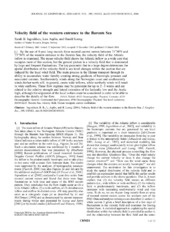Velocity field of the western entrance to the Barents Sea
Peer reviewed, Journal article
Published version
Permanent lenke
https://hdl.handle.net/1956/375Utgivelsesdato
2004-03-13Metadata
Vis full innførselSamlinger
Originalversjon
https://doi.org/10.1029/2003jc001811Sammendrag
By the use of 4-year long records from moored current meters between 71°30′N and 73°30′N of the western entrance to the Barents Sea, the velocity field of the Atlantic inflow is examined. The mean velocity field shows the Atlantic inflow as a wide core that occupies most of this section, but the general picture is a velocity field that is dominated by large and frequent fluctuations. The key parameter that to a large degree determines the spatial distribution of the velocity field is sea level changes within the section that are induced by the local wind field. The main process is the Ekman transport through its ability to accumulate water thereby creating strong gradients of barotropic pressure and associated currents. Southwesterly winds along the Norwegian coast and southeasterly winds farther north will, in general, create wide inflows, while northerly winds will result in wide outflows. These flow regimes may be persistent for up to 2–3 weeks and are related to the relative strength and lateral extension of the Icelandic low and the Arctic high, although the alignment of the local isobars must be considered in order to be able to describe the details of the flow.
